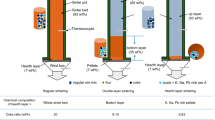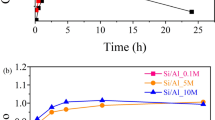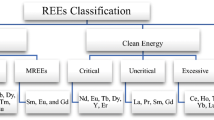Abstract
The bulk of the world's phosphate reserves is located in sedimentary horizons that contain appreciable amounts of carbonate. During beneficiation of phosphate rocks, huge amounts of oversize phosphate rocks are rejected from crushers. This reject also mostly contains low tricalcium phosphate content and high carbonate content. In this work, various experiments have been carried out to reduce the carbonate content by leaching the ground phosphate rock with dilute formic acid solution in order to get marketable and industrially acceptable phosphate grades. By using this technique, the effect of formic acid concentration, reaction time, process temperature and liquid/solid ratio (vol./wt. basis) have been studied. It was found that upon treatment of the ground rock with formic acid, the P2O5 percent can be raised by up to 29% corresponding to a reduction of about 69% in the calcium carbonate content of the samples, depending on the reaction conditions as well as nature and size of the raw phosphate particles used for analysis.
Similar content being viewed by others
References
Abu-Eishah SI, EI-Jallad IS, Muthaker M, Touqan M & Sadeddin W (1991) Beneficiation of calcareous phosphate rocks using dilute acetic acid solution: Optimization of operating conditions for Ruseifa (Jordan) Phosphate. Int J Miner Proc 31: 115–126.
Alfantazi AM & Amaratunga LM (1993) The upgrading of a Sri Lankan phosphate ore by froth flotation. J Mines Metals Fuels 41: 54–59.
AI-Fariss TF, Ozbelge HO & Abdulrazik AM (1991) Flotation of a carbonate rich sedimentary phosphate rock. Fert Res 29: 203–208.
Arafa MA (1993) Beneficiation of a calcareous and carbonaceous phosphate ore. Modell Meas Cont 43: 1–22.
Baudet G (1988) The processing of phosphate ores. Chron Rech Min (Special issue on Phosphates) 67.
Baumann AN & Snow RE (1980) 2nd Int Cong on Phosphate Compounds Proceedings, April 21–25, Boston, p 269.
Brierley C (1982) Pour la Science 60: 38
Ciccu R, Ghiani M, Peretti R, Sstta F & Zucca A (1993) Electrostatic upgrading of phosphate ores. Proc Int Cong Mineral Processing. 18th, pp 433–438.
Costa ACA, Medronho RA & Pecanha RP (1992) Phosphate rock bioleaching. Biotechnol Lett 14: 233–238.
Crago A (1940) Process of Concentrating Phosphate Minerals. US Patent No 2,293,640.
EI-Jalead IS, Abouzeid AZM & EI-Sinbawy HA (1980) Powder Technol 26: 187.
Good PC (1976) Beneficiation of Unweathered Indian Calcareous Phosphate Rock by Calcination and Hydration. US Bureau of Mines, Report No 8154, Washington DC, USA.
Hanna HS & Somasundaran P (1976) In: MC Fuestenau (ed) Flotation of salt Type Minerals, pp 197–272. AM Gandin Memorial Volume, AIME, New York, USA.
Harrison JR & AP (1984) Ann Rev Microbiol 38: 265.
Hawley GG (1984) The Condensed Chemical Dictionary. 10th ed. Galgotia Book Source Pub, New Delhi, India.
Hegner P & Pacl Z (1974) Res Inst of Inorganic Chemistry, 40060 USTI NAD Labem, Czechoslovakia, Report No PTE/74/12, 21P.
Hignett TP (1980) Production of Wet-Process Phosphoric Acid. Proc Int Cong Phosphorus Compounds. 2nd, pp 401–429.
Hignett TP, Doll EC, Livingston OH & Raistrick B (1977) New Developments in Phosphate Fertilizer Technology, 273 Proc. Carpentier LJ (ed) Sci Pub Co Elsevier.
Hollick CT & Wright R (1986) Recent trends in phosphate mineral beneficiation. Trans Inst Miner Metall Section A-Mining 95: A150–154.
Hsieh SS (1988) Beneficiation of a Dolomitic phosphate pebble from Florida. Ind Eng Chem Res 27: 594–596.
Hutchins SR & Davidson MS (1986) Ann Rev Microbiol 40: 311.
Ince DE (1987) Effect of sodium chloride on the selective flotation of dolomite from apatite. Ph.D. Thesis, University of Florida USA.
Jeppsson L, Fredholm D & Mattiasson BO (1985) J Paleontol 59: 952.
Judd JC & Harbuck DD (1993) Beneficiation and digestion of Georgia offshore phosphates. Marine Geores Geotechnol 11: 245–257.
Kangnian Z, Yin H & Hengxing X (1994) Separation of apatite and dolomite. J Youse Jinshu 46: 31–38.
Lawver JE, Mcclintock WO & Snow RE (1978) Miner Sci Eng 10: 278.
Lawver JE, Weigel RL, Snow RE & Huang CL (1982) Beneficiation of Dolomitic Florida Phosphate Reserves. In: 14th Int Miner Proc C ong Session iv Flotation, Paper iv-20.
Lodha TR, Sinha NK & Srivastava AC (1984) Chem Age India 35: 15.
Mew MC (1980) World Survey of Phosphate Deposits. 4th edn, p 2. The British Sulfur Corp. Ltd, London, UK.
Morrison RT & Boyd RN (1983) Organic Chemistry. 4th ed. Allyn and Bacon Inc, Boston, USA.
Moudgil BM & Chanchani R (1985a) Flotation of apatite and dolomite using sodium oleate as collector. Miner Metall Proc 2(1): 13.
Moudgil BM & Chanchani R (1985b) Selective flotation of dolomite from francolite using two-stage conditioning. Miner Metall Proc 2(1): 19.
Moudgil BM, Ince DE, Vasudevan TV & Sober D (1990) Bench-scale optimization of the two-stage conditioning process for apatite dolomite separation. Miner Metall Proc 7(1): 53.
Ray H & Robert JP (1969) Fluidized bed processing of phosphate rock. Miner Proc 10: 13–17.
Robinson N (1978) Fisons' Experience on the effect of Phosphate Rock Impurities on the Phosphoric Acid Plant Performance. ISMA (IFA), Orlando, USA.
Sadeddin W & Abu-Eishah SI (1990) Minimization of free calcium carbonate in hard and medium-hard phosphate rocks using dilute acetic acid solution. Int J Miner Proc 30: 113–125.
Somasundaran P (1975) On the problem of separation of calcite from calcareous apatite. In: 11th Int Miner Proc Cong Cagliari 2: 155–156.
Zafar IZ (1993) Beneficiation of low grade carbonate-rich phosphate rocks using dilute acetic acid solution. Fert Res 34: 173–180.
Zafar IZ, Anwar MM & Pritchard DW (1995) Optimization of thermal beneficiation of a low grade dolomitic phosphate rock. Int J Miner Process 43: 123–131.
Zhong K, Vasudevan TV & Somasundaran P (1991) Beneficiation of a high dolomitic phosphate ore: A bench scale optimization study. Miner Eng 4: 563–571.
Author information
Authors and Affiliations
Rights and permissions
About this article
Cite this article
Zafar, Z.I., Anwar, M.M. & Pritchard, D.W. A new route for the beneficiation of low grade calcareous phosphate rocks. Fertilizer Research 44, 133–142 (1995). https://doi.org/10.1007/BF00750803
Received:
Accepted:
Issue Date:
DOI: https://doi.org/10.1007/BF00750803




